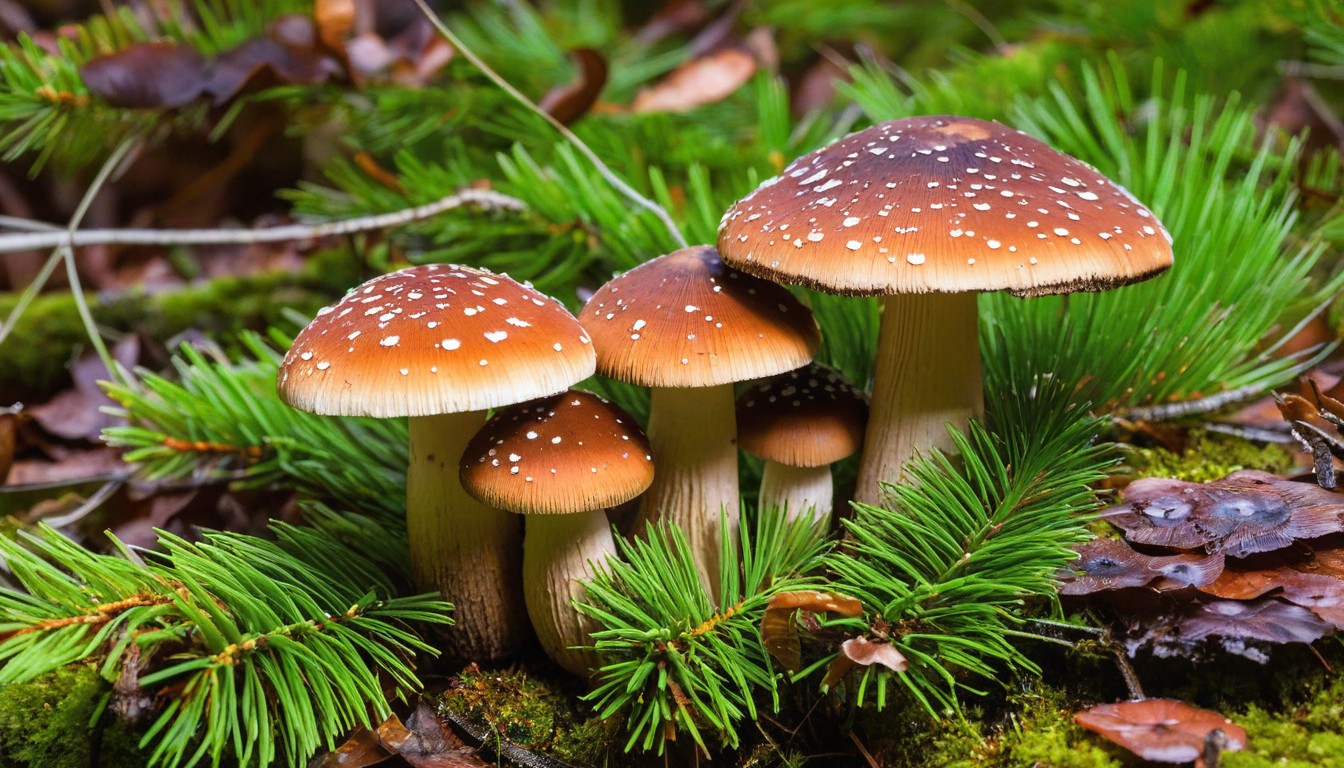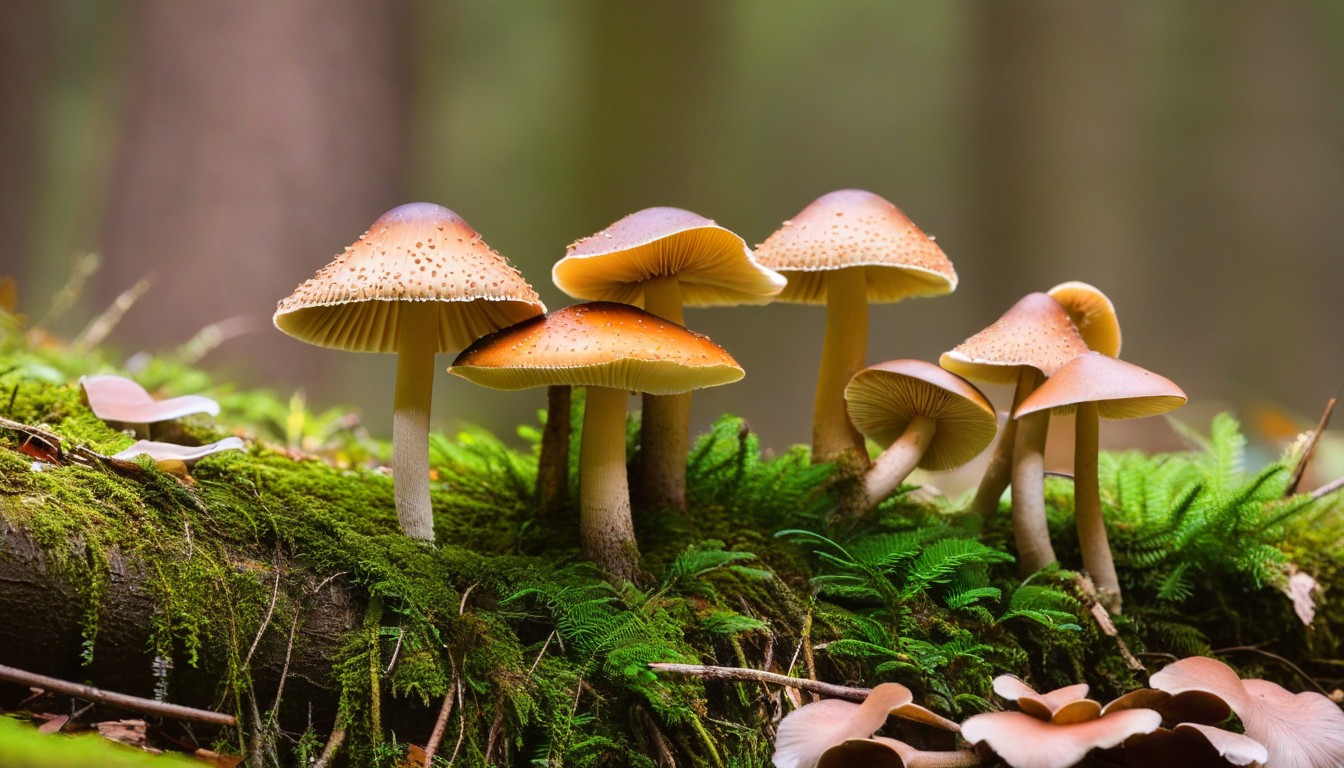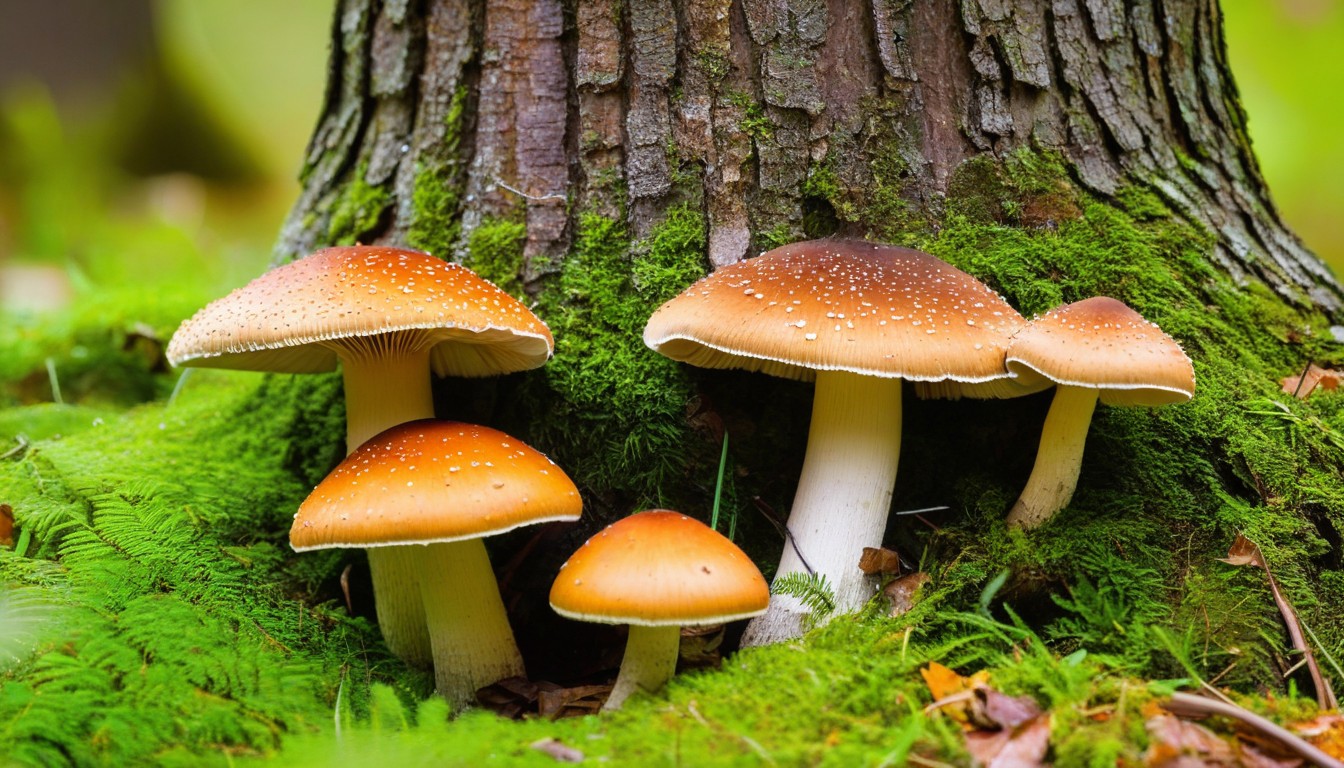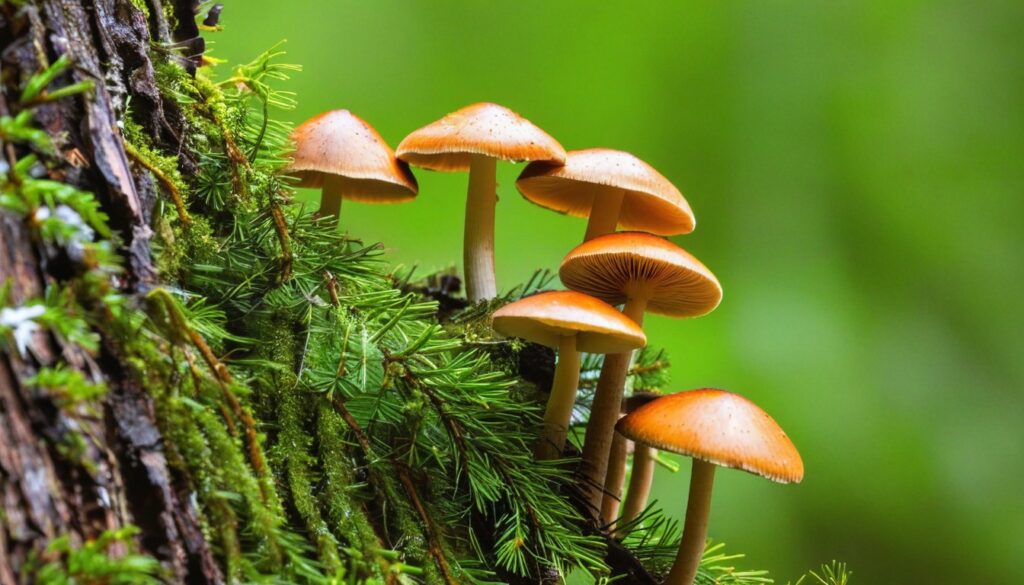Are you a fan of foraging? If you haven’t yet tried Pine Tree Mushrooms, you’re in for a treat! These delightful fungi offer unique flavors and culinary joys that are simply unparalleled.
Found in the wild and nestled among the pines, these mushrooms are a true treasure to discover. They offer a delicious umami flavor that is buttery and savory, making them an ideal ingredient in a wide range of dishes. The texture is meaty and firm, making them perfect for stir-fries, stews, and soups.
If you’re looking for a new culinary adventure, Pine Tree Mushrooms are definitely worth exploring. Read on to learn more about these fascinating fungi and how to include them in your meals.
Key Takeaways
- Foragers can discover unique flavors and culinary joys in Pine Tree Mushrooms found in the wild.
- The mushrooms offer an umami taste that is buttery and savory, making them perfect for a variety of dishes.
- Pine Tree Mushrooms have a meaty and firm texture, which makes them ideal in stir-fries, stews, and soups.
- Culinary adventurers can expand their cooking repertoire with the incorporation of this fungi.
- By foraging Pine Tree Mushrooms in a sustainable manner, enthusiasts can contribute to the preservation of this species and their ecosystems.
The Origin and Characteristics of Pine Tree Mushrooms
Pine Tree Mushrooms, also known as Matsutake Mushrooms, are highly-prized for their delicious flavor and are found in coniferous forests throughout the Northern Hemisphere. Historically, they have been revered in Japan and Korea as a delicacy.
These mushrooms thrive in damp and cool environments, particularly under pine trees, where they form a symbiotic relationship with the trees. This mycorrhizal association, also known as a mutually beneficial relationship, involves the fungus supporting the growth of the tree roots while simultaneously receiving carbohydrates from the tree.
Characteristics | Description |
|---|---|
Appearance | The cap of the Pine Tree Mushroom is generally round or oval-shaped and ranges in color from brownish-grey to reddish-brown. The stem is cream-colored and can be quite thick. A distinctive feature of the Pine Tree Mushroom is the persistent veil that creates a veil-like ring around the stem. |
Flavor and Aroma | Pine Tree Mushrooms have a distinct and earthy flavor profile with hints of spice and a slightly sweet aroma. |
Season | Pine Tree Mushrooms are typically found in the autumn months, from September to November depending on the location. |
One unique characteristic of the Pine Tree Mushroom is its aroma, which has been described as a blend of cinnamon, pine, and forest floor. It is this unique smell, combined with its delicious flavor, that has earned the Pine Tree Mushroom its status as a highly-prized culinary delicacy.
With its unique flavor and symbiotic relationship with pine trees, the Pine Tree Mushroom is a fascinating and delightful find for foragers and mushroom enthusiasts alike.
Pine Tree Mushroom Foraging Tips and Techniques

Foraging for Pine Tree Mushrooms can be a thrilling and rewarding adventure. Here are some practical tips and techniques to help you succeed:
1. Know the Best Seasons
The best time to find Pine Tree Mushrooms is usually in the fall, from September to November. You can also find them in the spring, but they are less common. Keep an eye out for new pine tree growth, which is where the mushrooms will typically be found.
2. Find the Ideal Locations
Pine Tree Mushrooms grow in a symbiotic relationship with pine trees, so it’s important to look for areas with plenty of pine trees. Look for forests or woodlands with a varied mix of pine species, which will increase your chances of finding the mushrooms. Consult with local foragers to identify the best locations in your area.
3. Use the Right Tools
Make sure to bring a basket, mesh bag, or foraging pouch to carry your mushroom finds. A sharp pocket knife or mushroom hunting knife can also be useful for cleanly cutting the mushrooms from their stems. Avoid using plastic bags, as they can cause the mushrooms to sweat and spoil more quickly.
4. Know Your Pine Trees and Mushrooms
Pine Tree Mushrooms have a distinct look and grow in specific types of pine trees. Familiarize yourself with the different pine tree species in your area and the identifying features of Pine Tree Mushrooms. It’s also important to be able to distinguish Pine Tree Mushrooms from toxic look-alikes, such as the deadly Galerina marginata.
5. Experiment with Cooking Techniques
Pine Tree Mushrooms have a unique flavor that can be enhanced by different cooking techniques. Try sautéing, grilling, pickling, or even incorporating them into baking recipes. Experiment with flavors and textures to find your perfect preparation method.
With these tips and techniques, you’ll be on your way to foraging Pine Tree Mushrooms like a pro.
Identifying Pine Tree Mushrooms in the Wild
If you’re interested in foraging for Pine Tree Mushrooms, it’s important to first learn how to identify them in the wild. While they have unique characteristics, there are some look-alikes to be aware of. Here are some key features and descriptions to help you distinguish Pine Tree Mushrooms from other wild mushrooms.
Name | Features | Description |
|---|---|---|
Pine Tree Mushroom | Cap | The cap of the Pine Tree Mushroom is usually dark brown or black, with a velvety texture. It can grow up to 10cm in diameter and is slightly curved, resembling a shallow bowl. |
Gills | The gills of this mushroom are white and spaced quite far apart. They’re attached securely to the stem, not running down it. | |
Stem | The stem is quite thick and has a fibrous texture. It’s usually white or light brown and can grow up to 10cm in length. It’s also slightly curved and often thicker at the base. | |
Smell and Taste | The Pine Tree Mushroom has a strong, pleasant smell and taste, resembling that of pine needles. | |
Dangerous Look-Alike | False Morel | The False Morel looks similar to the Pine Tree Mushroom but has different gills and has folds instead of gills. Eating False Morels can cause severe health conditions, so it’s important to know the difference. |
By paying close attention to these details, you can confidently identify Pine Tree Mushrooms and avoid potential danger from toxic look-alikes.
The Flavors and Culinary Uses of Pine Tree Mushrooms

Pine Tree Mushrooms, or Matsutake, possess a distinct earthy, woody flavor that is highly valued in Japanese cuisine. Their aroma alone is enough to entice any food lover. When cooked, the flavor deepens, and it pairs well with various ingredients.
In addition to being a star ingredient in dishes such as soups, sauces, and rice dishes, Pine Tree Mushrooms have also been used in traditional herbal remedies for centuries due to their medicinal properties.
Culinary Uses of Pine Tree Mushrooms
The best way to experience the unique flavor of Pine Tree Mushrooms is to keep it simple. Sauteing them with olive oil and garlic enhances their signature aroma, and adding them to a stir-fry brings a unique twist to the dish.
Pine Tree Mushrooms also work well in soups and stews. Classic Japanese soup, sukiyaki, is a popular dish that features freshly foraged Pine Tree Mushrooms. The mushrooms pair well with other ingredients like tofu, noodles, and soy sauce, enhancing their meaty flavor.
Table: Complementary Ingredients for Pine Tree Mushroom
Ingredient | Description |
|---|---|
Rice | Nutty, chewy rice perfectly pairs with the earthy flavor of Pine Tree Mushrooms, creating the perfect Asian-inspired dish. |
Soy Sauce | Soy sauce adds the right amount of saltiness and umami flavor to Pine Tree Mushrooms, creating a deliciously savory combination. |
Garlic | The pungent aroma of garlic enhances the earthy flavor of Pine Tree Mushrooms, bringing out their distinct aroma and taste. |
Using Pine Tree Mushrooms in various dishes can elevate the flavor profile of any food, From hearty soups to simple sauteed mushrooms; these foraged treasures offer a unique culinary experience.
Cooking Techniques and Recipes for Pine Tree Mushrooms

Ready to explore the delightful culinary uses of Pine Tree Mushrooms? Here are some tips and tricks to make the most of these unique fungi.
Cooking Techniques
When it comes to Pine Tree Mushrooms, less is often more. These beauties boast a delicious, distinct flavor that shines through when cooked simply. Some popular techniques include:
- Sautéing in butter or oil
- Grilling or roasting with a simple seasoning of salt and pepper
- Adding to soups or stews for a hearty umami flavor
Experiment with these techniques to find your personal favorite.
Recipes
Want to take your Pine Tree Mushroom feast up a notch? Check out these delectable recipes:
Name | Description |
|---|---|
Pine Tree Mushroom Risotto | A creamy risotto made with buttery Pine Tree Mushrooms and finished with parmesan cheese and fresh herbs. |
Grilled Pine Tree Mushrooms with Balsamic Glaze | Perfectly grilled Pine Tree Mushrooms drizzled with a tangy balsamic glaze. |
Pine Tree Mushroom and Goat Cheese Tart | A savory tart filled with earthy Pine Tree Mushrooms, creamy goat cheese, and caramelized onions. Perfect for brunch or lunch. |
These recipes highlight the unique flavors and textures of Pine Tree Mushrooms, and are sure to impress friends and family.
Health Benefits of Pine Tree Mushrooms
Pine Tree Mushrooms are a treasure trove of health benefits. These fungi are a rich source of antioxidants, vitamins, and minerals, making them an excellent addition to any diet.
Nutritional Value | Amount per 100g |
|---|---|
Calories | 38 kcal |
Protein | 3.6g |
Fat | 0.3g |
Carbohydrates | 5.3g |
Vitamin D | 25 IU |
Riboflavin (B2) | 0.31mg |
Niacin (B3) | 1.44mg |
Pantothenic Acid (B5) | 0.38mg |
Iron (Fe) | 0.5mg |
Manganese (Mn) | 0.76mg |
Zinc (Zn) | 1.1mg |
The high levels of antioxidants in Pine Tree Mushrooms can help boost the immune system and prevent cellular damage caused by oxidative stress. The beta-glucans found in these mushrooms have also been linked to improved cholesterol levels and reduced risk of heart disease.
Research has also revealed that Pine Tree Mushrooms possess potential anti-cancer properties. Their polysaccharides have been shown to inhibit tumor growth and enhance the effects of chemotherapy.
Furthermore, Pine Tree Mushrooms exhibit anti-inflammatory properties, making them a useful addition to any anti-inflammatory diet. They may also have neuroprotective effects, improving cognitive function and protecting against age-related cognitive decline.
“Pine Tree Mushrooms are a flavorful and nutritious addition to any diet. Their potential health benefits, including anti-cancer and anti-inflammatory properties, make them a standout ingredient in any dish.”
Safety Precautions and Risks When Foraging Pine Tree Mushrooms

Foraging for Pine Tree Mushrooms can be a thrilling and rewarding experience, but it’s important to take safety precautions and be aware of the potential risks involved. To ensure a safe foraging experience, here are some essential tips to keep in mind:
- Always properly identify Pine Tree Mushrooms before harvesting. They should have dense caps and a unique piney aroma.
- Avoid harvesting mushrooms with slimy caps or that have a fishy smell, as these may be toxic varieties that resemble Pine Tree Mushrooms.
- Carry a mushroom guidebook with you to cross-reference the characteristics of Pine Tree Mushrooms and to distinguish them from poisonous lookalikes.
- Wear proper protective clothing, including gloves, long sleeves, and pants, to prevent contact with harmful plants or insects.
- Never pick mushrooms from areas with heavy pollution, traffic, or near chemical-treated fields.
Additionally, it’s important to be aware of the potential risks involved in mushroom foraging. In rare cases, people have suffered from mushroom poisoning after consuming toxic varieties. Symptoms of mushroom poisoning can range from mild nausea to severe cramps, vomiting, and diarrhea. In extreme cases, mushroom poisoning can lead to liver or kidney failure.
It’s important to always err on the side of caution when foraging for mushrooms and to never consume anything unless you’re 100% certain of its identity and safety.
In summary, Pine Tree Mushrooms can be a safe and enjoyable food source when proper precautions are taken. By knowing how to identify Pine Tree Mushrooms, wearing protective clothing, and being aware of potential risks, you can ensure a successful and memorable foraging experience.
Preserving and Storing Pine Tree Mushrooms
Preserving Pine Tree Mushrooms lets you prolong your foraged mantel of flavorful fun. To retain their unique taste, aroma, and overall quality, different preservation methods come handy. In this section, we explore methods such as drying, freezing, and pickling, and how they can help you preserve Pine Tree Mushrooms for future culinary uses.
Drying pine tree mushrooms
Drying is a classic technique used in mushroom preservation. Dried mushrooms are easily stored and serve as a great flavor enhancer in soups, stews, and stocks.
Steps for Drying Pine Tree Mushrooms: |
|---|
|
Freezing pine tree mushrooms
Freezing is another efficient preservation method that retains the taste and texture of Pine Tree Mushrooms when properly done. It’s best for mushrooms that have high water content, as they tend to lose quality quickly.
Steps for Freezing Pine Tree Mushrooms: |
|---|
|
Pickling pine tree mushrooms
Pickling adds a tangy flavor to Pine Tree Mushrooms while preserving them. It’s relatively simple to pickle mushrooms and achieving your desired level of taste is flexible.
Steps for Pickling Pine Tree Mushrooms: |
|---|
|
Preserving Pine Tree Mushrooms is essential to ensure an abundant supply every time you’d like to savor the flavors and nutrients they bring to the table. By following the above discussed preservation methods, you can store these fascinating fungi to keep your meals exciting and delightful for a long time.
Pine Tree Mushrooms and Sustainability
Foraging Pine Tree Mushrooms can be a sustainable and rewarding activity, provided that it’s done responsibly and with respect for the environment. As foragers, we have a responsibility to ensure that we’re not depleting natural resources or damaging ecosystems. Here are some important sustainability considerations for foraging Pine Tree Mushrooms:
- Only harvest mature mushrooms and leave small or damaged ones as they help to spread spores and ensure the continuing growth of the species.
- Do not over-harvest or clear out entire areas when foraging. Leave a portion for other foragers, wildlife, and future growth.
- Always be mindful of the ecosystem and natural surroundings. Avoid trampling on plants or disturbing animal habitats.
- Be aware of any regulations or restrictions regarding mushroom foraging in your area, and follow them accordingly.
- Consider supporting local conservation organizations to help protect natural habitats and promote sustainability practices.
By adopting sustainable foraging practices, we can help to preserve the natural beauty and diversity of our surroundings, and the unique flavors of Pine Tree Mushrooms can continue to delight for years to come.
Cultural Significance and Historical Uses of Pine Tree Mushrooms
Pine Tree Mushrooms have been used both for culinary and medicinal purposes for centuries. Cultures worldwide have recognized the unique availability and flavor these mushrooms have to offer.
In Chinese culture, Pine Tree Mushrooms are known as Song Rong, meaning pine tree mushroom. The Chinese have used these mushrooms in traditional medicine for centuries and believe them to have healing properties, particularly in strengthening the immune system and promoting longevity. They are also a staple in many Chinese dishes, particularly soups and stews.
In Japan, Pine Tree Mushrooms are called matsutake, and they are highly prized for their unique flavor. Japanese cuisine often features these mushrooms in dishes such as soups, noodle dishes, and rice bowls. Matsutake is also a popular ingredient in traditional Japanese tea ceremonies.
The mushroom is so highly valued in Japan that prices can reach over $2,000 per kilogram.
Pine Tree Mushrooms are also popular in European cuisine, particularly in Russia and Nordic countries, where they are used in soups, stews, and baked dishes.
Native American cultures also recognize the unique qualities of Pine Tree Mushrooms. The Ojibwe tribe in North America considers them a traditional food, which they used to gather in cedar swamps.
Region | Historical Uses |
|---|---|
China | Traditional medicine, soups, and stews |
Japan | Tea ceremonies, soups, noodle dishes, and rice bowls |
Russia | Soups, stews, and baked dishes |
Nordic countries | Soups, stews, and baked dishes |
North America | Traditional food among the Ojibwe tribe |
The cultural significance of Pine Tree Mushrooms highlights their role in advancing the culinary arts while also recognizing their potential health benefits. As you forage Pine Tree Mushrooms, be sure to appreciate the cultural and historical significance of these unique fungi and honor them with responsible, sustainable foraging practices.
Conclusion
Foraging for Pine Tree Mushrooms can be an exciting and rewarding experience. Not only do these unique mushrooms offer a myriad of distinctive culinary flavors, but they also provide numerous health benefits. It’s important to approach foraging with caution and follow proper safety protocols to ensure a safe and sustainable experience.
By incorporating Pine Tree Mushrooms into our diets, we can enjoy their culinary joys and simultaneously support the preservation of these fungi and their ecosystems. From identifying Pine Tree Mushrooms in the wild to cooking them to perfection, we hope this article has inspired you to embark on your own foraging adventure.
Remember to always approach foraging with respect for nature and its delicate balance. Happy foraging!
FAQ
What are Pine Tree Mushrooms?
Pine Tree Mushrooms, also known as Tricholoma magnivelare, are a type of wild edible mushroom found in coniferous forests. They are highly sought after by foragers for their unique flavors and culinary joys.
Where can I find Pine Tree Mushrooms?
Pine Tree Mushrooms can be found in coniferous forests across North America, particularly in regions with abundant pine trees. Look for them near the base of mature pine trees, as they have a symbiotic relationship with the tree roots.
How do Pine Tree Mushrooms look?
Pine Tree Mushrooms have a distinctive appearance. They have a convex to flat cap, usually ranging from 2 to 8 inches in diameter, with a pale yellow to dark brown color. The cap often has concentric rings and a texture that resembles dry suede.
Are Pine Tree Mushrooms safe to eat?
Yes, Pine Tree Mushrooms are safe to eat for most people. However, exercise caution when foraging and make sure to properly identify them to avoid any toxic look-alike species. If you’re unsure, consult an experienced forager or mycologist.
What do Pine Tree Mushrooms taste like?
Pine Tree Mushrooms have a unique flavor profile. They are often described as earthy, nutty, and slightly sweet. Their flavor pairs well with a variety of dishes, making them a versatile ingredient in the culinary world.
Can I cook Pine Tree Mushrooms?
Absolutely! Pine Tree Mushrooms are delicious when cooked. They can be sautéed, grilled, roasted, or used in soups, stews, and stir-fries. Their flavors add depth and complexity to any dish they’re used in.
Are there any health benefits of consuming Pine Tree Mushrooms?
Yes, Pine Tree Mushrooms offer several health benefits. They are rich in antioxidants, vitamins, and minerals, which contribute to overall well-being. They also have potential anti-inflammatory properties and can support a healthy immune system.
Are there any safety precautions when foraging Pine Tree Mushrooms?
While Pine Tree Mushrooms are generally safe to forage and consume, it is important to take safety precautions. Always properly identify the mushrooms before consuming them, as certain toxic look-alike species exist. Additionally, handle mushrooms with clean hands and store them properly to avoid spoilage.
How can I preserve and store Pine Tree Mushrooms?
There are various methods to preserve and store Pine Tree Mushrooms. They can be dried, frozen, or pickled to extend their shelf life. Proper storage techniques help maintain their flavors and quality for future use.
Is foraging Pine Tree Mushrooms sustainable?
Yes, foraging for Pine Tree Mushrooms can be sustainable if done responsibly. When foraging, only harvest a portion of the mushrooms, leaving enough behind for future growth and reproduction. Take care to minimize any damage to the surrounding ecosystem and respect private property rules.
What are the historical uses of Pine Tree Mushrooms?
Pine Tree Mushrooms have a rich cultural history and have been used in various cuisines and traditional practices. Indigenous cultures often incorporated them into their meals, herbal medicines, and spiritual ceremonies. They continue to be valued for their unique flavors and cultural significance.

